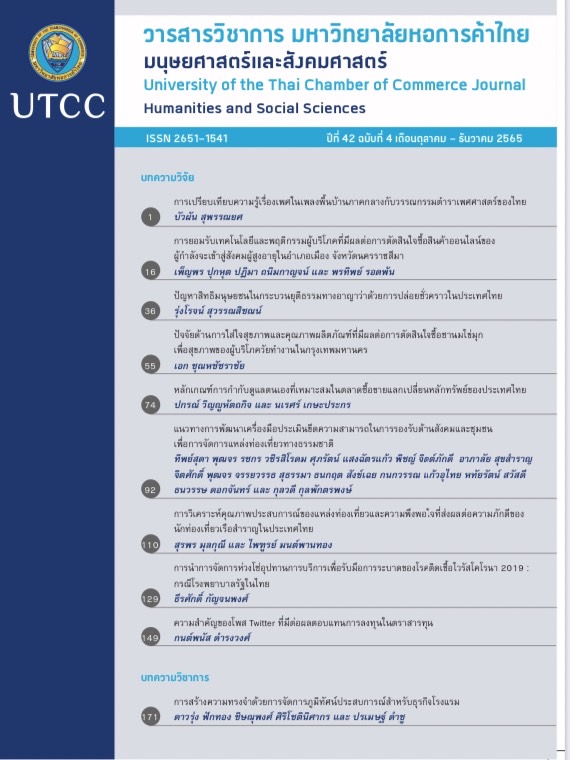ความสำคัญของโพส Twitter ที่มีต่อผลตอบแทน การลงทุนในตราสารทุน
Main Article Content
บทคัดย่อ
งานวิจัยฉบับนี้ มุ่งศึกษาผลกระทบของอารมณ์ความรู้สึกของนักลงทุนต่อราคาหุ้นในตลาดรอง โดยอาศัยดัชนีบ่งชี้ความสุข ซึ่งชี้วัดจากข้อความในทวิตเตอร์ (Twitter sentiment index) เป็นดัชนีบ่งชี้อารมณ์ความรู้สึกของนักลงทุน อาศัยระเบียบวิธี hierarchical regressions หลักฐานเชิงประจักษ์ในงานวิจัยบ่งชี้ว่า ดัชนีชี้วัดความสุขจาก Twitter ส่งผลกระทบอย่างมีนัยสำคัญต่อราคาหุ้นที่ซื้อขายในตลาดรองในสหรัฐอเมริกา ทั้งนี้ ปัจจัยผลกระทบดังกล่าว ไม่อาจอธิบายได้โดยตัวแปรทางการเงินที่มีอยู่เดิมในแบบจำลองราคาหลักทรัพย์ที่เป็นที่รู้จักดีในปัจจุบัน (อาทิเช่น ค่าชดเชยความเสี่ยงตลาด (Market Risk Premium), อัตราผลตอบแทนของ
สินทรัพย์ปราศจากความเสี่ยง (Risk-Free Rate), อัตราส่วนราคาทางบัญชีต่อราคาตลาด (B/M Ratio) หรือเทรดดิ้งโมเมนตัม) ดังนั้น ผู้มีส่วนได้เสียในตลาดหุ้น อาทิเช่น นักลงทุน ผู้จัดการกองทุน ควรมีความรู้ความเข้าใจถึงผลกระทบของอารมณ์ความรู้สึกของนักลงทุนที่สะท้อนจากสื่อโซเชียลมีเดีย ซึ่งอาจส่งกระทบต่อ
ผลตอบแทนและความเสี่ยงของพอร์ทลงทุน
Article Details

This work is licensed under a Creative Commons Attribution-NonCommercial-NoDerivatives 4.0 International License.
ลิขสิทธิ์ของบทความ
ผลงานที่ได้รับการตีพิมพ์ถือเป็นลิขสิทธิ์ของมหาวิทยาลัยหอการค้าไทย ห้ามมิให้นำเนื้อหา ทัศนะ หรือข้อคิดเห็นใด ๆ ของผลงานไปทำซ้ำ ดัดแปลง หรือเผยแพร่ ไม่ว่าทั้งหมดหรือบางส่วนโดยไม่ได้รับอนุญาตเป็นลายลักษณ์อักษรจากมหาวิทยาลัยหอการค้าไทยก่อน
References
Baker, M., & Stein, J. C. (2004). Market liquidity as a sentiment indicator. Journal of Financial Markets, 7(3), 271-299. doi: 10.1016/j.finmar.2003.11.005
Baker, M., & Wurgler, J. (2006). Investor sentiment and the cross-section of stock returns. Journal of Finance, 61(4), 1645-1680. doi: 10.1111/j.1540-6261.2006.00885.x
Baker, M., & Wurgler, J. (2007). Investor sentiment in the stock market. Journal of Economic Perspectives, 21(2), 129-152.
Baker, M., Wurgler, J., & Yuan, Y. (2012). Global, local, and contagious investor sentiment. Journal of Financial Economics, 104(2), 272-287. doi: 10.1016/j.jfineco.2011.11.002
Black, F. (1986). Noise. Journal of Finance, 41(3), 529-543.
Carhart, M. (1997). On persistence in mutual fund performance. Journal of Finance, 52(1), 57-82.
Da, Z., Engelberg, J., & Gao, P. (2015). The sum of all FEARS investor sentiment and asset prices. Review of Financial Studies, 28(1), 1-32. doi: 10.1093/rfs/hhu072
Daniel, K., Hirshleifer, D., & Subrahmanyam, A. (1998). Investor psychology and security market under- and overreactions. Journal of Finance, 53(6), 1839-1885
De Long, J. B., Shleifer, A., Summers, L. H., & Waldmann, R. J. (1990). Noise trader risk in financial markets. Journal of Political Economy, 98(4), 703-738.
Dergiades, T. (2012). Do investors’ sentiment dynamics affect stock returns? Evidence from the US economy. Economic Letters, 116(3), 404-407. doi: 10.1016/j.econlet.2012.04.018
Dickey, D. A., & Fuller, W. A. (1979). Distribution of the estimators for autoregressive time series with a unit root. Journal of the American Statistical Association, 74(366), 427-431.
Ding, W., Mazouz, K., & Wang, Q. (2019). Investor sentiment and the cross-section of stock returns: New theory and evidence. Review of Quantitative Finance and Accounting, 53(2), 493-525.
Dodds, P. S., Harris, K. D., Kloumann, I. M., Bliss, C. A., & Danforth, C. M. (2011). Temporal patterns of happiness and information in a global social network: Hedonometrics and Twitter. PLoS One, 6(12), e26752. doi: 10.1371/journal.pone.0026752
Fama, E. F., & French, K. R. (1993). Common risk factors in the returns on stocks and bonds. Journal of Financial Economics, 33(1), 3-56. doi: 10.1016/0304-405X(93)90023-5
Fama, E. F., & French, K. R. (2015). A five-factor asset pricing model. Journal of Financial Economics, 116(1), 1-22. doi: 10.1016/j.jfineco.2014.10.010
Fama, E. F., & French, K. R. (2020). Comparing cross-section and time-series factor models. Review of Financial Studies, 33(5), 1891-1926. doi: 10.1093/rfs/hhz089
French, K. R. (2021). French data library. Retrieved January 20, 2021, from https://mba.tuck.
dartmouth.edu/pages/faculty/ken.french/data_library.html
Gibbons, M. R., Ross, S., & Shanken, J. (1989). A test of the efficiency of a given portfolio.Econometrica, 57(5), 1121-52.
Kaplanski, G., Levy, H., Veld, C., & Veld-Merkoulova, Y. (2015). Do happy people make optimistic investors? Journal of Financial and Quantitative Analysis, 50(1/2), 145-168
Kemp, S. (2020). Global report 2020. Retrieved February 3, 2021, from https://www.hootsuite.com/pages/digital-2020
Kim S., & Kim, D. (2014). Investor sentiment from internet message postings and the predictability of stock returns. Journal of Economic Behavior & Organization, 107(Pt. B), 708-729. doi: 10.1016/j.jebo.2014.04.015
Lee, C. M. C., Shleifer, A., & Thaler, R. H. (1991). Investor sentiment and the closed-end fundpuzzle. Journal of Finance, 46(1), 75-109.
Lemmon, M., & Portniaguina, E. (2006). Consumer confidence and asset prices: Some empirical evidence. Review of Financial Studies, 19(4), 1499-1529.
Naeem, M. A., Farid, S., Balli, F., & Shahzad, S. J. H. (2020). Can happiness predict future volatility instock markets? Research in International Business and Finance, 54, 101298.doi:10.1016/j. ribaf.2020.101298
Phillips, P. C. B., & Perron, P. (1988). Testing for a unit root in time series regression. Biometrika,75(2), 335-346.
Shleifer, A., & Summers, L. H. (1990). The noise trader approach to finance. Journal of Economic Perspectives, 4(2), 19-33.
Shleifer, A., & Vishny, R. W. (1997). The limits of arbitrage. Journal of Finance, 52(1), 35-55.
Siganos, A., Vagenas-Nanos, E., & Verwijmeren, P. (2014). Facebook’s daily sentiment and international stock markets. Journal of Economic Behavior & Organization, 107(Pt. B), 730-743. doi: 10.1016/j.jebo.2014.06.004
Zhang, W., Li,X., Shen, D., & Teglio, A. (2016). Dailyhappiness andstock returns: Some international evidence. Physica A: Statistical Mechanics and its Applications, 460,201-209.doi:10.1016/j. physa.2016.05.026
Zhang, W., Wang, P., Li, X., & Shen, D. (2018). Twitter’s daily happiness sentiment and international stock returns: Evidence from linear and nonlinear causality tests. Journal of Behavioral and Experimental Finance, 18, 50-53. doi: 10.1016/j.jbef.2018.01.005
Zhao, R. (2020). Quantifying the cross sectional relation of daily happiness sentiment and stock return: Evidence from US. Physica A: Statistical Mechanics and its Applications, 538, 122629. doi: 10.1016/j.physa.2019.122629

